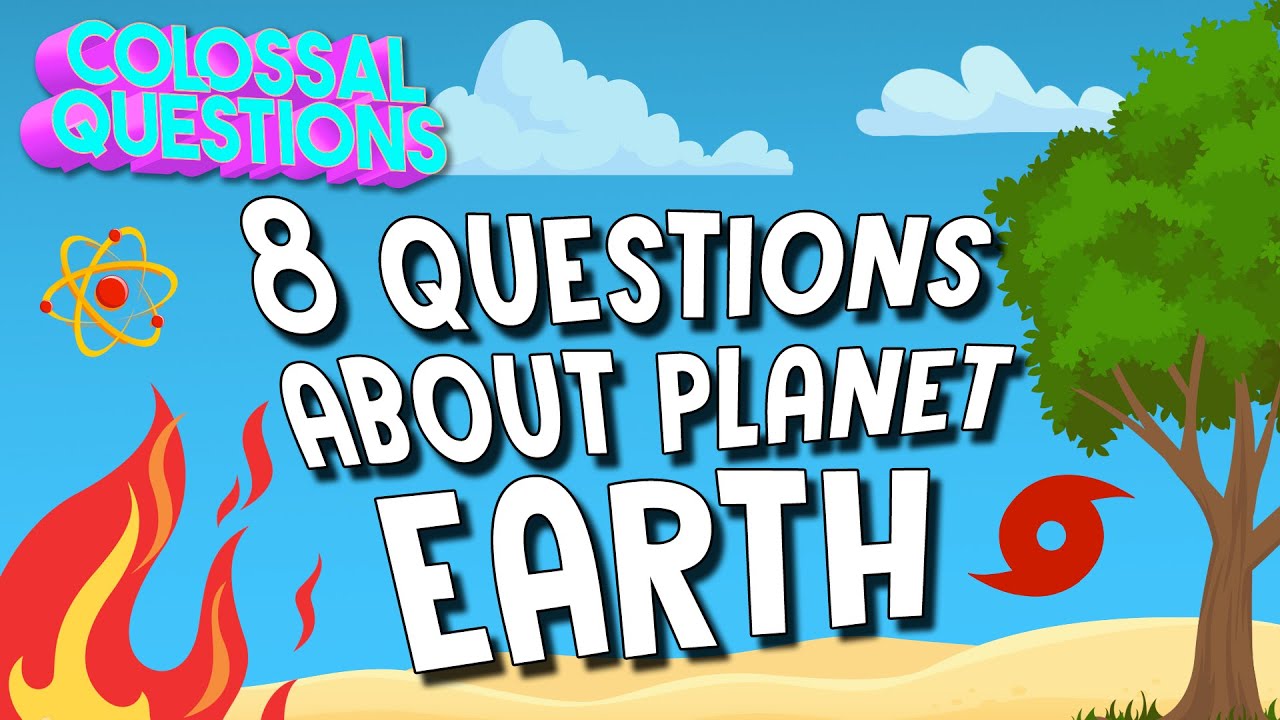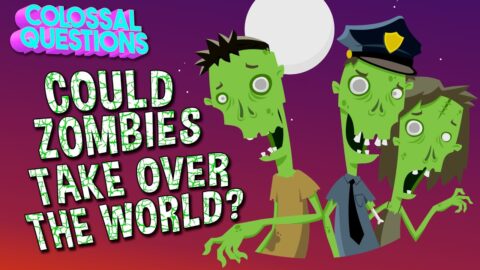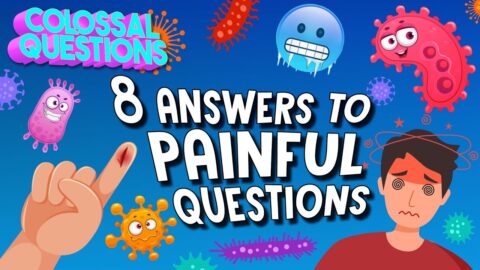Colossal Questions.
Perguntas Colossais.
Why do hurricanes get names?
Por que os furacões recebem nomes?
Every year around the end of the summer, hurricane season
Todos os anos, perto do fim do verão, a temporada de furacões
starts in the US when huge tropical storms
começa nos EUA quando grandes tempestades tropicais
start to pop up.
começam a aparecer.
These massive storms are rated on a scale from 1 to 5,
Essas tempestades massivas são classificadas em uma escala de 1 a 5,
1 being the weakest type of hurricane and 5
1 sendo o tipo mais fraco de furacão e 5
being the most severe and dangerous.
sendo o mais severo e perigoso.
But even a Category 1 hurricane, the smallest kind,
Mas mesmo um furacão de categoria 1, o menor tipo,
has winds between 74 and 95 miles-per-hour.
tem ventos entre 120 e 153 quilômetros por hora.
Any storm that's Category 3, 4 or 5
Qualquer tempestade de categoria 3, 4 ou 5
is considered a major hurricane that's
é considerado um grande furacão que é
likely to cause damage to buildings and the environment.
susceptíveis de causar danos aos edifícios e ao meio ambiente.
Category 5 hurricanes happen whenever
Furacões de categoria 5 acontecem sempre
the wind is blowing at more than 157 miles-per-hour.
o vento está soprando a mais de 252 km/h.
That is very dangerously windy.
Isso é muito perigosamente ventoso.
Buildings, roofs, trees, and power poles
Edifícios, telhados, árvores e postes de energia
are all at risk of being severely damaged
correm todos o risco de sofrer danos graves
when the wind is whipping around that fast.
quando o vento sopra tão rápido.
Part of what makes a hurricane so dangerous
Parte do que torna um furacão tão perigoso
is that unlike other natural disasters,
é que, ao contrário de outros desastres naturais,
like an earthquake or a tornado, a hurricane
como um terremoto ou um tornado, um furacão
can last for a long time.
pode durar muito tempo.
Sometimes, longer than a week.
Às vezes, mais de uma semana.
That's because hurricanes are huge weather systems that
Isso ocorre porque os furacões são enormes sistemas climáticos que
move pretty slowly.
mova-se bem devagar.
Only about 10 to 20 miles-per-hour.
Apenas cerca de 10 a 20 milhas por hora.
Creeping along slowly means the rain, waves,
Rastejando lentamente significa a chuva, as ondas,
and wind all have plenty of time to damage
e o vento têm tempo de sobra para causar danos
whatever it's passing through.
seja lá o que for que esteja passando.
Hurricanes only develop over warm water that's
Os furacões só se desenvolvem sobre águas quentes
80 degrees Fahrenheit or above.
80 graus Fahrenheit ou mais.
When the warm, wet air over the tropical water rises,
Quando o ar quente e úmido sobre as águas tropicais sobe,
it's replaced by cooler air from above.
é substituído por ar mais frio vindo de cima.
That new cooler air will then start
Esse novo ar mais frio começará então
to warm up and rise, being replaced by new cool air again.
para aquecer e subir, sendo substituído novamente por ar fresco.
When this cycle is repeated over and over again,
Quando esse ciclo se repete uma e outra vez,
huge storm clouds eventually start to form.
enormes nuvens de tempestade eventualmente começam a se formar.
These clouds start to spin with the rotation of the planet
Essas nuvens começam a girar com a rotação do planeta
and get bigger while wind speeds increase,
e ficam maiores à medida que a velocidade do vento aumenta,
only causing the cycle to happen faster,
apenas fazendo com que o ciclo aconteça mais rápido,
and eventually forming a fully-fledged hurricane.
e eventualmente formando um furacão completo.
Nowadays, hurricanes are each given their own individual name
Hoje em dia, cada furacão recebe seu próprio nome individual
for one simple reason.
por uma razão simples.
It makes it much easier for meteorologists
Isso torna muito mais fácil para os meteorologistas
to track and identify each hurricane forming.
para rastrear e identificar cada furacão em formação.
Since there's often multiple hurricanes
Como geralmente há vários furacões
forming at any one time.
formando a qualquer momento.
sometimes in the same area of the ocean, naming them
às vezes na mesma área do oceano, nomeando-os
simply makes things less confusing.
simplesmente torna as coisas menos confusas.
Since 1979, the names have been picked
Desde 1979, os nomes foram escolhidos
by the World Meteorological Organization, who
pela Organização Meteorológica Mundial, que
use six lists of male and female names to choose from.
use seis listas de nomes masculinos e femininos para escolher.
The lists have a name for each letter of the alphabet,
As listas têm um nome para cada letra do alfabeto,
except for Q, U, and Z. So next time the power goes out
exceto Q, U e Z. Então, da próxima vez que a energia acabar
and you're hunkered down safely during a storm, well,
e você está agachado em segurança durante uma tempestade, bem,
at least you know you can bust out this semi-useless fact
pelo menos você sabe que pode revelar esse fato semi-inútil
to pass the time when you're bored.
para passar o tempo quando você estiver entediado.
What is air actually made out of?
Do que o ar realmente é feito?
Most people assume that the air around us
A maioria das pessoas assume que o ar ao nosso redor
is mostly made of oxygen. After all, we
é feito principalmente de oxigênio. Afinal, nós
know we need to breathe in oxygen in order to survive.
sabemos que precisamos respirar oxigênio para sobreviver.
But the truth is, oxygen only makes up
Mas a verdade é que o oxigênio só compõe
a fraction of the air we're sucking in with every breath.
uma fração do ar que inalamos a cada respiração.
The exact oxygen level in the air
O nível exato de oxigênio no ar
can change depending on where you are.
pode mudar dependendo de onde você está.
But generally, it's only about 21% of the air.
Mas, em geral, representa apenas 21% do ar.
The closer you get to the ocean, the higher the percentage.
Quanto mais perto você estiver do oceano, maior será a porcentagem.
And the farther away you get, the lower the oxygen levels.
E quanto mais longe você chega, menores são os níveis de oxigênio.
So for example, if you were standing
Então, por exemplo, se você estivesse de pé
at the peak of a tall mountain range,
no pico de uma alta cadeia de montanhas,
you'll have much lower levels of oxygen in the air.
você terá níveis muito mais baixos de oxigênio no ar.
How low?
Quão baixo?
Well, at the peak of Mount Everest, the highest mountain
Bem, no pico do Monte Everest, a montanha mais alta
on Earth, oxygen levels are only about one-third of the average.
na Terra, os níveis de oxigênio são apenas cerca de um terço da média.
Why?
Por que?
Well, about 50% to 80% of all the oxygen on Earth
Bem, cerca de 50% a 80% de todo o oxigênio da Terra
comes from our oceans.
vem dos nossos oceanos.
Most of that oxygen comes from plankton,
A maior parte desse oxigênio vem do plâncton,
tiny pieces of plant, algae or bacteria
pequenos pedaços de plantas, algas ou bactérias
that can turn sunlight into oxygen.
que pode transformar a luz solar em oxigênio.
OK, so now we know that only about 21% of the air we breathe
OK, então agora sabemos que apenas cerca de 21% do ar que respiramos
is actually made up of oxygen and sometimes
é na verdade composto de oxigênio e às vezes
even less than that.
ainda menos que isso.
But then what makes up the other 79% of air we suck up all day?
Mas então o que compõe os outros 79% de ar que sugamos durante o dia?
Well, it turns out that about 78% of the air
Bem, acontece que cerca de 78% do ar
is actually made up of another common gas that,
na verdade é composto de outro gás comum que,
honestly, doesn't do much for our breathing at all.
sinceramente, não faz muita diferença na nossa respiração.
Nitrogen.
Azoto.
That's right, even though nitrogen makes up
Isso mesmo, mesmo que o nitrogênio constitua
more than three-quarters of the air,
mais de três quartos do ar,
we simply breathe it in and breathe it
nós simplesmente respiramos e respiramos
right back out again unchanged.
de volta novamente sem alterações.
So between nitrogen making up about 78%
Então, entre o nitrogênio que compõe cerca de 78%
of the air and oxygen making up another 21%,
do ar e do oxigênio que compõem outros 21%,
that makes up 99% of the air we breathe.
que compõe 99% do ar que respiramos.
So what makes up that final 1%?
Então o que compõe esse 1% final?
All kinds of things.
Todos os tipos de coisas.
Trace amounts of other gases, like argon, carbon dioxide,
Vestígios de outros gases, como argônio, dióxido de carbono,
nitrous oxide, neon, helium, hydrogen, or methane, just
óxido nitroso, néon, hélio, hidrogênio ou metano, apenas
to name a few.
para citar alguns.
There's also differing amounts of water vapor
Também há quantidades diferentes de vapor de água
in the air at any time depending on how humid it is outside.
no ar a qualquer momento, dependendo da umidade do lado de fora.
There's more water vapor in the air on hot summer days
Há mais vapor de água no ar nos dias quentes de verão
and less in the cold of winter.
e menos no frio do inverno.
And that's not all you can find in the final 1% of the air.
E isso não é tudo o que você pode encontrar no 1% final do ar.
Dust, pollen, microbes, spores, and even things
Poeira, pólen, micróbios, esporos e até coisas
like scent particles also help make up
como partículas de perfume também ajudam a compor
that last little sliver.
aquela última lasquinha.
So even though we might not be able to see the air around us,
Então, mesmo que não consigamos ver o ar ao nosso redor,
now we know almost 80% of it is honestly kind of useless.
agora sabemos que quase 80% disso é honestamente inútil.
The more know.
Quanto mais souber.
What will the Earth be like 1,000 years from now?
Como será a Terra daqui a 1.000 anos?
Technology is continuing to process
A tecnologia continua a processar
at such an amazingly fast pace that chances
em um ritmo tão incrivelmente rápido que as chances
are things could look very different even
as coisas podem parecer muito diferentes mesmo
in the near future.
num futuro próximo.
So 1,000 years from now, well, if you ask experts,
Então, daqui a 1.000 anos, bem, se você perguntar aos especialistas,
things could get very different.
as coisas podem ficar muito diferentes.
For starters, humans might look a little more sci-fi.
Para começar, os humanos podem parecer um pouco mais ficção científica.
Some experts think it might become common for people
Alguns especialistas acreditam que pode se tornar comum para as pessoas
to implant tech, break into their bodies.
para implantar tecnologia, invadir seus corpos.
Kind of like a real life cyborg.
Como um ciborgue da vida real.
Programs, medical bots, and nanobots
Programas, bots médicos e nanobots
could revolutionize surgery.
poderia revolucionar a cirurgia.
And synthetic brain implants could maybe even
E implantes cerebrais sintéticos poderiam até mesmo
make us capable of downloading skills on the spot,
nos tornam capazes de baixar habilidades no local,
accessing the internet with just our thoughts,
acessando a internet apenas com nossos pensamentos,
and much, much more.
e muito, muito mais.
And it's not just our physical appearance
E não é só a nossa aparência física
that might change in the next thousand years.
isso pode mudar nos próximos mil anos.
Given the rate that the processing power of computers
Dada a taxa em que o poder de processamento dos computadores
is progressing, there's a chance that we could end up
está progredindo, há uma chance de que possamos acabar
with supercomputers that can perform
com supercomputadores que podem executar
and think as fast or faster than a human brain.
e pensar tão rápido ou mais rápido que um cérebro humano.
These artificially intelligent computers
Esses computadores com inteligência artificial
would be able to speak, listen, and learn faster
seria capaz de falar, ouvir e aprender mais rápido
than the human mind, making them smarter
do que a mente humana, tornando-os mais inteligentes
than humans, which could definitely
do que os humanos, o que definitivamente poderia
pose its own problems.
colocar seus próprios problemas.
So yeah, the truth is it's not all sunshine and rainbows
Então sim, a verdade é que nem tudo são flores
when you try to predict ahead 1,000 years.
quando você tenta prever 1.000 anos à frente.
And it's not just the technology that we
E não é só a tecnologia que nós
might need to worry about.
talvez precise se preocupar.
We could be in for some light extinction
Poderíamos estar prestes a uma extinção leve
that far in the future.
tão distante no futuro.
Now, no need to panic.
Agora, não precisa entrar em pânico.
The Earth isn't in the brink of an instantaneous mass
A Terra não está à beira de uma massa instantânea
destruction.
destruição.
That would take something highly dramatic,
Isso exigiria algo altamente dramático,
like, oh, I don't know, a massive meteor.
tipo, ah, não sei, um meteoro enorme.
But what the Earth does seem primed
Mas o que a Terra parece preparada
for is possible mass extinctions of lots of plants and animals
pois é possível a extinção em massa de muitas plantas e animais
we know today as we continue to populate and pollute
sabemos hoje que continuamos a povoar e poluir
our planet.
nosso planeta.
Already in the past 100 years, the rate
Já nos últimos 100 anos, a taxa
of extinction for species across the planet
de extinção de espécies em todo o planeta
was 100 times higher than normal due to human impact.
foi 100 vezes maior que o normal devido ao impacto humano.
That's significant.
Isso é significativo.
And if the trend continues for the next several hundred years,
E se a tendência continuar pelos próximos cem anos,
well, then, we might lose a lot of the plants and animals
bem, então, podemos perder muitas plantas e animais
we take for granted today.
que tomamos como garantidos hoje.
Luckily, there is always a chance
Felizmente, sempre há uma chance
that we slowly start to change how we interact with the planet
que lentamente começamos a mudar a forma como interagimos com o planeta
and decide to develop brand new tech in time that
e decidir desenvolver uma tecnologia totalmente nova a tempo
helps solve some of our issues before it's too late.
ajuda a resolver alguns dos nossos problemas antes que seja tarde demais.
There's already tons of people around the world working
Já existem toneladas de pessoas trabalhando em todo o mundo
to solve these problems.
para resolver esses problemas.
And in 1,000 years, well, there's
E em 1.000 anos, bem, haverá
no telling what genius solutions we
não dá para dizer que soluções geniais nós temos
might find to stave off extinctions and help the planet
pode encontrar maneiras de evitar extinções e ajudar o planeta
thrive.
florescer.
Nanotechnology powered by the sun
Nanotecnologia alimentada pelo sol
might be able to clean up the land, air, and sea
pode ser capaz de limpar a terra, o ar e o mar
like super advanced Roombas.
como Roombas superavançados.
And in the future, we might continue
E no futuro, poderemos continuar
to develop cleaner sources of energy that
para desenvolver fontes de energia mais limpas que
require a lot less drilling, spilling,
exigem muito menos perfuração, derramamento,
and polluting the skies.
e poluindo os céus.
Hey, there's always a chance, right?
Ei, sempre há uma chance, certo?
And if not, well, there's already
E se não, bem, já existe
plenty of people who think that 1,000 years from now humans
muitas pessoas pensam que daqui a 1.000 anos os humanos
might not need to live on Earth at all.
talvez nem precisem viver na Terra.
We could have human colonies on the moon, Mars, or even a
Poderíamos ter colônias humanas na Lua, em Marte ou até mesmo em um
yet to be discovered Earth-like planet somewhere else
planeta semelhante à Terra ainda a ser descoberto em algum outro lugar
in the galaxy.
na galáxia.
It sounds far-fetched, but scientists have already
Parece rebuscado, mas os cientistas já
found more than 40 billion Earth-like planets
encontrou mais de 40 bilhões de planetas semelhantes à Terra
in our galaxy alone.
somente em nossa galáxia.
So who knows, maybe it all won't be science fiction after all.
Então, quem sabe, talvez tudo isso não seja ficção científica, afinal.
Why are all of the planets round?
Por que todos os planetas são redondos?
You probably know that there's eight planets
Você provavelmente sabe que existem oito planetas
in our solar system.
no nosso sistema solar.
And you might know that those eight planets
E você pode saber que esses oito planetas
can be pretty different.
pode ser bem diferente.
Some are massive and others are relatively small.
Alguns são enormes e outros são relativamente pequenos.
Some are rocky and others are made up of gas.
Algumas são rochosas e outras são feitas de gás.
Some spin super fast and others don't do much spinning at all.
Alguns giram super rápido e outros não giram muito.
But no matter the difference, each
Mas não importa a diferença, cada um
and every planet we've ever found
e todos os planetas que já encontramos
in our solar system or anywhere else in the galaxy
no nosso sistema solar ou em qualquer outro lugar da galáxia
are all round.
são todos redondos.
Well, what's the deal?
Bem, qual é o problema?
Why can't planets be any other shape?
Por que os planetas não podem ter outro formato?
Well, it has to do with how planets are formed.
Bem, tem a ver com como os planetas são formados.
It all starts when little bits of molten space
Tudo começa quando pequenos pedaços de espaço derretido
debris, like liquid hot chunks of rock or gases
detritos, como pedaços líquidos quentes de rocha ou gases
bump into each other and start to clump together.
colidem umas com as outras e começam a se aglomerar.
Eventually, after collecting enough debris,
Eventualmente, depois de coletar detritos suficientes,
the big glob becomes heavy enough
o grande globo fica pesado o suficiente
that it starts to have a good amount of gravity.
que começa a ter uma boa quantidade de gravidade.
Gravity is the force that holds stuff together
A gravidade é a força que mantém as coisas unidas
in space, pulling everything towards the center.
no espaço, puxando tudo para o centro.
Now a big, heavy floating lump, it
Agora um grande e pesado pedaço flutuante,
starts to orbit its nearby star, pulling anything in its path
começa a orbitar sua estrela próxima, puxando tudo em seu caminho
into its gravity along the way, making it
em sua gravidade ao longo do caminho, tornando-o
even bigger and even globbier.
ainda maior e ainda mais globular.
The big molten baby planet's gravity
A gravidade do grande planeta bebê derretido
pulls equally as hard from all sides, which basically means
puxa igualmente forte de todos os lados, o que basicamente significa
that everything is about as equally
que tudo é quase tão igualmente
close to the center of the planet as anything else,
perto do centro do planeta como qualquer outra coisa,
making it a ball.
fazendo uma bola.
So, that's why all the planets in our solar system are round.
Então é por isso que todos os planetas do nosso sistema solar são redondos.
But some are rounder than others.
Mas algumas são mais redondas que outras.
For instance, Mercury and Venus are both almost perfectly
Por exemplo, Mercúrio e Vênus são quase perfeitamente
round, like floating marbles.
redondos, como bolinhas de gude flutuantes.
Saturn is a bit thicker around the middle,
Saturno é um pouco mais grosso no meio,
making it the least round planet in our solar system.
tornando-o o planeta menos redondo do nosso sistema solar.
Why that extra thickness?
Por que essa espessura extra?
Well, think of a big spinning planet a bit like a carousel.
Bem, pense em um grande planeta girando, como um carrossel.
The faster you spin, the harder it is to stay on
Quanto mais rápido você gira, mais difícil é permanecer
and the easier it is to get thrown right off.
e mais fácil é ser jogado para fora.
This is called centrifugal force.
Isso é chamado de força centrífuga.
And it works the same way for things as colossal as planets,
E funciona da mesma forma para coisas tão colossais como planetas,
too.
também.
As the planet slowly cools down and eventually hardens,
À medida que o planeta esfria lentamente e eventualmente endurece,
it keeps its bulging shape.
mantém sua forma protuberante.
So, sorry to burst your bubble if you were holding out
Então, desculpe estourar sua bolha se você estava esperando
hope that scientists might find a strangely shaped planet
espero que os cientistas possam encontrar um planeta de formato estranho
somewhere out there in space.
em algum lugar lá fora no espaço.
But hey, you know what they say, never say never.
Mas ei, você sabe o que dizem, nunca diga nunca.
Why are most plants green?
Por que a maioria das plantas é verde?
In order to understand why most plants are green,
Para entender por que a maioria das plantas são verdes,
we'll first have to learn how we even
primeiro teremos que aprender como nós até mesmo
see color in the first place.
veja a cor em primeiro lugar.
You see, every time you look at something,
Veja, toda vez que você olha para alguma coisa,
you're not actually seeing the color of the thing itself.
você não está realmente vendo a cor da coisa em si.
Instead, when light shines on an object,
Em vez disso, quando a luz brilha sobre um objeto,
it absorbs some colors from the light and reflects others.
ela absorve algumas cores da luz e reflete outras.
The colors we see when looking at stuff
As cores que vemos quando olhamos para as coisas
is actually just the light that different objects
na verdade é apenas a luz que diferentes objetos
are reflecting back into our eyeballs.
estão refletindo de volta em nossos olhos.
Trippy, right?
Alucinante, certo?
So the reason grass, leaves, and other plants
Então a razão pela qual a grama, as folhas e outras plantas
look green is because the plants are absorbing
parecer verde é porque as plantas estão absorvendo
all the other colors and just reflecting the color green back
todas as outras cores e apenas refletindo a cor verde de volta
to our eyes.
aos nossos olhos.
OK, so that's how we see colors.
OK, então é assim que vemos as cores.
But why green?
Mas por que verde?
Why do most plants only reflect green back at us
Por que a maioria das plantas só reflete verde para nós?
while absorbing the rest?
enquanto absorve o resto?
Well, that has to do with a very special chemical inside plants
Bem, isso tem a ver com uma substância química muito especial dentro das plantas
called chlorophyll, which is what
chamada clorofila, que é o que
they use to make their food.
eles usam para fazer sua comida.
The chlorophyll inside the leaves
A clorofila dentro das folhas
traps light from the sun.
captura a luz do sol.
The plant then uses that stored up light energy
A planta então usa a energia luminosa armazenada
to change water and chemicals in the air into sugars
para transformar água e produtos químicos no ar em açúcares
and oxygen. The plant eats the sugars
e oxigênio. A planta come os açúcares
and releases the oxygen, which we breathe.
e libera o oxigênio que respiramos.
This whole process is called photosynthesis.
Todo esse processo é chamado de fotossíntese.
And it's super important.
E é super importante.
Why?
Por que?
Because without it, plants couldn't eat
Porque sem ela as plantas não poderiam comer
and we couldn't breathe.
e não conseguíamos respirar.
And none of that would be possible without chlorophyll,
E nada disso seria possível sem a clorofila,
which just so happens to absorb all the reds, blues,
que por acaso absorve todos os vermelhos, azuis,
and other colors, and reflects green light back
e outras cores, e reflete a luz verde de volta
into your eyes.
em seus olhos.
That's also why some parts of the plant
É também por isso que algumas partes da planta
might look more green than others.
podem parecer mais verdes do que outros.
There's usually a lot more chlorophyll
Geralmente há muito mais clorofila
in the leaves than the stem of a plant, which
nas folhas do que no caule de uma planta, o que
is why the stems aren't usually quite as dark.
é por isso que os caules geralmente não são tão escuros.
And not all parts of a leaf always
E nem todas as partes de uma folha sempre
have the same amount of chlorophyll.
têm a mesma quantidade de clorofila.
Some leaves have light green, white, or yellow stripes
Algumas folhas têm listras verdes claras, brancas ou amarelas
or spots on them.
ou manchas neles.
There's also some plants that have yellow, red, purple,
Existem também algumas plantas que têm amarelo, vermelho, roxo,
or orange leaves year-round and never look green.
ou folhas alaranjadas o ano todo e nunca ficam verdes.
Don't worry, those plants get to eat too.
Não se preocupe, essas plantas também comem.
They still have plenty of green chlorophyll in them.
Elas ainda têm bastante clorofila verde.
But those kinds of plants also have
Mas esses tipos de plantas também têm
lots of other chemicals in their leaves that are other colors.
muitos outros produtos químicos em suas folhas que são de outras cores.
Enough to blot out the chlorophyll's green hue.
O suficiente para apagar a tonalidade verde da clorofila.
So, why are plants green?
Então, por que as plantas são verdes?
Because chlorophyll is green and plants are full of it.
Porque a clorofila é verde e as plantas são cheias dela.
So whenever you see a nice green plant,
Então, sempre que você vir uma bela planta verde,
you can thank that special green light
você pode agradecer aquela luz verde especial
bouncing chemical chlorophyll.
clorofila química saltitante.
What's the absolute deepest point in the ocean?
Qual é o ponto mais profundo do oceano?
Throughout history, if you wanted
Ao longo da história, se você quisesse
to measure just how deep a body of water was,
para medir a profundidade de um corpo de água,
you had to tie a weight to a rope
você teve que amarrar um peso em uma corda
and let it drop to the bottom.
e deixe cair no fundo.
Then, measure how much rope when in the water.
Depois, meça a quantidade de corda quando estiver na água.
Not too hard.
Não muito difícil.
But when it comes to the ocean, it
Mas quando se trata do oceano,
would take thousands of feet of rope
seriam necessários milhares de metros de corda
to measure some of the deeper parts.
para medir algumas das partes mais profundas.
So for centuries, no one really knew
Então, durante séculos, ninguém realmente sabia
just how deep our oceans are.
quão profundos são os nossos oceanos.
That is until the late 1800s, when a British Navy ship named
Isso foi até o final de 1800, quando um navio da Marinha Britânica chamado
the HMS Challenger set out on a voyage
o HMS Challenger partiu em uma viagem
to learn more about the briny deep.
para aprender mais sobre as profundezas salgadas.
The ship was outfitted with over 900,000 feet of hemp rope.
O navio foi equipado com mais de 900.000 pés de corda de cânhamo.
More than enough to reach even the deepest, darkest places.
Mais do que suficiente para alcançar até os lugares mais profundos e escuros.
During the four-year journey, the crew of the Challenger
Durante a viagem de quatro anos, a tripulação do Challenger
managed to find the bottom of the ocean, the Mariana Trench.
conseguiu encontrar o fundo do oceano, a Fossa das Marianas.
This massive crack in the Pacific Ocean
Esta enorme fenda no Oceano Pacífico
stretches for more than 1,500 miles.
estende-se por mais de 2.400 quilômetros.
Even still, the HMS Challenger found
Mesmo assim, o HMS Challenger encontrou
what is maybe the single deepest point now known
qual é talvez o ponto mais profundo conhecido atualmente
as the Challenger Deep on the Southern end of the Mariana
como o Challenger Deep no extremo sul das Marianas
Trench.
Trincheira.
Nowadays, experts use high-tech, state-of-the-art sonar
Hoje em dia, os especialistas usam sonar de alta tecnologia e de última geração
technology to precisely map the ocean floor,
tecnologia para mapear com precisão o fundo do oceano,
giving us a much clearer picture of what the trench looks like
nos dando uma imagem muito mais clara de como é a trincheira
and exactly how far down the Challenger Deep really goes.
e exatamente até onde realmente vai o Challenger Deep.
35,856 feet.
35.856 pés.
That's close to seven miles.
Isso dá quase 11 quilômetros.
That's deep.
Isso é profundo.
Really, really deep.
Muito, muito profundo.
How deep exactly?
Qual a profundidade exata?
Well, the diving limit for recreational scuba divers
Bem, o limite de mergulho para mergulhadores recreativos
is 130 feet.
é de 130 pés.
That's about the height of a large building.
Isso é mais ou menos a altura de um edifício grande.
Pretty deep.
Bem profundo.
Blue whales, the biggest known creatures
Baleias azuis, as maiores criaturas conhecidas
to ever live on Earth, can dive down to more than 1,500 feet.
que já viveu na Terra, pode mergulhar a mais de 1.500 pés.
Double that depth to 3,000 feet and sunlight
Duplique essa profundidade para 3.000 pés e luz solar
can no longer penetrate the water.
não pode mais penetrar na água.
The wreck of the Titanic sits on the cold ocean floor
Os destroços do Titanic estão no fundo frio do oceano
about 12,000 feet underwater.
cerca de 12.000 pés debaixo d'água.
And on average, the Earth's oceans
E, em média, os oceanos da Terra
are about 14,000 feet deep.
estão a cerca de 14.000 pés de profundidade.
To put those depths into perspective,
Para colocar essas profundezas em perspectiva,
the tallest skyscraper in New York City
o arranha-céu mais alto da cidade de Nova York
is a mere 1,776 feet tall.
tem apenas 545 metros de altura.
The absolute deepest shipwreck ever uncovered
O naufrágio mais profundo já descoberto
sits at the bottom of the Philippine Sea
fica no fundo do mar das Filipinas
21,180 feet down.
21.180 pés abaixo.
The Atlantic Ocean goes even deeper than that,
O Oceano Atlântico é ainda mais profundo do que isso,
maxing out at 27,500 feet.
atingindo o máximo de 27.500 pés.
For comparison, Mount Everest, the highest place on Earth,
Para efeito de comparação, o Monte Everest, o lugar mais alto da Terra,
is 29,032 feet.
é 29.032 pés.
Just a few thousand feet taller than the Atlantic Ocean
Apenas alguns milhares de pés mais alto que o Oceano Atlântico
is deep.
é profundo.
Whoa.
Uau.
But even the mighty Everest can't
Mas nem mesmo o poderoso Everest pode
come close to competing with the Pacific Oceans Mariana Trench.
chegam perto de competir com a Fossa das Marianas do Oceano Pacífico.
The Challenger Deep, the deepest known point
O Challenger Deep, o ponto mais profundo conhecido
in the entire ocean, is an amazing 35,856 feet
em todo o oceano, são incríveis 35.856 pés
below the waves.
abaixo das ondas.
Because no light can penetrate that deep,
Porque nenhuma luz pode penetrar tão fundo,
and because the pressure of the water
e por causa da pressão da água
above is so insanely immense, only highly
acima é tão insanamente imenso, apenas altamente
specialized submersibles are able to venture down
submersíveis especializados são capazes de se aventurar
into Challenger Deep and explore it.
para o Challenger Deep e explorá-lo.
Down there are some of the most fascinating, strange,
Lá embaixo estão algumas das coisas mais fascinantes, estranhas,
and in some cases, horrifying creatures on the planet.
e em alguns casos, criaturas horripilantes no planeta.
And the more we explore, the more we find.
E quanto mais exploramos, mais encontramos.
Then, who knows what they'll find next.
Então, quem sabe o que eles encontrarão em seguida.
What are the Northern Lights?
O que é a aurora boreal?
The Northern Lights are a stunning series
A Aurora Boreal é uma série impressionante
of bright colors that appear to flutter
de cores brilhantes que parecem tremular
across the sky near the North Pole.
através do céu perto do Polo Norte.
The eerie natural phenomenon can make a normal night look a bit
O fenômeno natural assustador pode fazer uma noite normal parecer um pouco
like a science fiction film.
como um filme de ficção científica.
Most of the time, the Northern Lights glow green or blue.
Na maioria das vezes, a aurora boreal brilha em verde ou azul.
But they can also glow brown, red, or purple.
Mas elas também podem brilhar em marrom, vermelho ou roxo.
Experts call this kind of special light an aurora.
Especialistas chamam esse tipo de luz especial de aurora.
Way up near the North Pole, we call them the Northern Lights
Bem perto do Pólo Norte, nós as chamamos de Luzes do Norte
or Aurora Borealis.
ou Aurora Boreal.
Down near the South Pole, they're
Perto do Pólo Sul, eles estão
called the Southern lights or Aurora Australis.
chamada de aurora boreal ou aurora austral.
Makes sense.
Faz sentido.
But whether you're near the North Pole or the South,
Mas quer você esteja perto do Pólo Norte ou do Sul,
the view is all the same, a bright, colorful, all natural
a vista é toda a mesma, brilhante, colorida, totalmente natural
light show unlike anything you'd find at a theme park.
show de luzes diferente de tudo que você encontraria em um parque temático.
Like just about all the natural light you see on Earth,
Como quase toda a luz natural que você vê na Terra,
the Northern Lights come from the sun.
a aurora boreal vem do sol.
You see, from time to time huge amounts
Veja, de vez em quando grandes quantidades
of energy burst out of the sun.
de energia irrompeu do sol.
These are called solar flares.
Elas são chamadas de erupções solares.
They're a type of storm on the sun's surface.
Elas são um tipo de tempestade na superfície do sol.
When a flare happens, massive amounts of electrified gas
Quando ocorre uma explosão, grandes quantidades de gás eletrificado
burst out and flare up.
explodir e incendiar.
Hence, the name.
Daí o nome.
This gas is full of tiny atomic particles called electrons.
Este gás é cheio de pequenas partículas atômicas chamadas elétrons.
When the gas from a solar flare reaches Earth, some of it
Quando o gás de uma explosão solar atinge a Terra, parte dele
ends up in our atmosphere.
acaba na nossa atmosfera.
As those electrons from the sun finally
À medida que esses elétrons do sol finalmente
start to interact with different gases in the air,
começam a interagir com diferentes gases no ar,
it causes that strange, beautiful light show
isso causa aquele estranho e lindo espetáculo de luzes
in the sky.
no céu.
Why the different colors?
Por que as cores diferentes?
Well, it depends on which gases the electrons interact with.
Bem, depende de quais gases os elétrons interagem.
The most common color you see is lime green,
A cor mais comum que você vê é verde limão,
which is caused by oxygen molecules
que é causada por moléculas de oxigênio
between 60 and 150 miles up.
entre 60 e 150 milhas de altitude.
Once you go above 60 miles, the oxygen
Depois de passar de 60 milhas, o oxigênio
that mixes with the electrified gas becomes more of a yellow
que se mistura com o gás eletrificado torna-se mais amarelo
instead.
em vez de.
Above 250 miles, it turns a bright red color.
Acima de 400 km, ele adquire uma cor vermelha brilhante.
But this is more rare.
Mas isso é mais raro.
Blue and purple appear less often too.
Azul e roxo também aparecem com menos frequência.
They're caused by particles colliding
Elas são causadas por partículas que colidem
less than 60 miles up.
menos de 60 milhas acima.
At those heights, it's nitrogen, not oxygen
Nessas alturas, é nitrogênio, não oxigênio
that causes the lights to turn purple or blue.
que faz com que as luzes fiquem roxas ou azuis.
OK, so that's why the Northern Lights happen.
OK, então é por isso que a aurora boreal acontece.
But why do we only see them at the poles?
Mas por que só os vemos nos polos?
Well, that's because of the electric charge in the gas.
Bem, isso ocorre por causa da carga elétrica no gás.
You see, as those electrified gas particles
Veja, como essas partículas de gás eletrificadas
enter the atmosphere, Earth's magnetic fields
entrar na atmosfera, campos magnéticos da Terra
guide the electrical charge towards one of the two poles.
guiar a carga elétrica em direção a um dos dois polos.
All that built-up electric energy
Toda aquela energia elétrica acumulada
is finally let out in the form of flashy colors.
é finalmente liberada na forma de cores chamativas.
It's no wonder that people throughout history
Não é de se admirar que as pessoas ao longo da história
tried to find all sorts of mystical ways to explain it.
tentou encontrar todos os tipos de maneiras místicas de explicar isso.
Vikings thought it was caused by the shiny weapons
Os vikings achavam que era causado pelas armas brilhantes
of long dead Warriors.
de guerreiros mortos há muito tempo.
Inuit people believed they were the souls of animals.
O povo inuíte acreditava que eles eram almas de animais.
And the Menominee Indians thought
E os índios Menominee pensaram
the lights were the torches of giants
as luzes eram as tochas dos gigantes
living in the deep North.
vivendo no extremo Norte.
And it's no wonder why they were searching for an explanation.
E não é de se admirar que eles estivessem procurando uma explicação.
The unique beauty of Aurora Borealis
A beleza única da Aurora Boreal
still attracts people from thousands of miles away.
ainda atrai pessoas de milhares de quilômetros de distância.
So mystical or not, they're definitely mesmerizing.
Tão místicos ou não, eles são definitivamente hipnotizantes.
Just how hot is the center of the Earth?
Quão quente é o centro da Terra?
The center of the Earth is close to 4,000 miles
O centro da Terra está a cerca de 4.000 milhas
beneath our feet.
sob nossos pés.
That's deep, really deep.
Isso é profundo, muito profundo.
If you wanted to tunnel your way down
Se você quisesse fazer um túnel para descer
to the center of the Earth, you'd
para o centro da Terra, você
have to dig through the planet's four layers...
tem que escavar através das quatro camadas do planeta...
the crust, the mantle, the outer core, and the inner core.
a crosta, o manto, o núcleo externo e o núcleo interno.
The outer layer is the crust, made up
A camada externa é a crosta, composta
of solid rocks and minerals.
de rochas sólidas e minerais.
In all our years digging into the ground,
Em todos os nossos anos cavando o solo,
humans have never been able to dig past the crust,
os humanos nunca foram capazes de cavar além da crosta,
even with state-of-the-art equipment.
mesmo com equipamentos de última geração.
It's a bit like the crust of a pie, a thin, hard outside layer
É um pouco como a crosta de uma torta, uma camada externa fina e dura
that makes it look solid even if the insides are gooey.
que faz com que pareça sólido mesmo que o interior esteja pegajoso.
Compared to the other layers of the Earth,
Comparado com as outras camadas da Terra,
the crust is actually quite thin.
a crosta é realmente bem fina.
Under land, it ranges from 19 to over 40 miles thick.
Em terra firme, sua espessura varia de 30 a mais de 64 quilômetros.
But beneath the oceans, the crust
Mas abaixo dos oceanos, a crosta
can be just three miles thick.
pode ter apenas três milhas de espessura.
Considering that the center of the Earth is 4,000 miles down,
Considerando que o centro da Terra está a 4.000 milhas de profundidade,
just a few miles of crust isn't much.
apenas alguns quilômetros de crosta não é muita coisa.
Even still, humans have never managed
Mesmo assim, os humanos nunca conseguiram
to drill any deeper than 7.6 miles down.
para perfurar mais de 12,2 quilômetros de profundidade.
That deep, temperatures are so high...
Tão fundo, as temperaturas são tão altas...
over 350 degrees Fahrenheit-that the drilling equipment
mais de 350 graus Fahrenheit - que o equipamento de perfuração
breaks down in the unbearable heat.
quebra no calor insuportável.
350 degrees is hot.
350 graus é quente.
So hot that humans couldn't survive it.
Tão quente que os humanos não conseguiriam sobreviver.
Yet, it's not even close to how scorching hot
No entanto, não chega nem perto do quão escaldante é
it gets at the center of the Earth.
chega ao centro da Terra.
Below the crust is the largest layer, the mantle.
Abaixo da crosta está a maior camada, o manto.
It's also mostly solid rocks and minerals,
Também é composto principalmente de rochas e minerais sólidos,
mixed with soft, semi-solid areas of molten magma.
misturado com áreas macias e semissólidas de magma derretido.
The mantle is over 1,800 miles thick
O manto tem mais de 1.800 milhas de espessura
and is mostly made up of elements
e é composto principalmente de elementos
like iron, magnesium, and silicon.
como ferro, magnésio e silício.
Beneath the mantle is the Earth's core,
Abaixo do manto está o núcleo da Terra,
which is split into two sections, the outer core
que é dividido em duas seções, o núcleo externo
and the inner core.
e o núcleo interno.
The outer core is big, almost 1,400 miles thick.
O núcleo externo é grande, com quase 2.250 quilômetros de espessura.
And it's mostly made of liquid iron and nickel.
E é feito principalmente de ferro líquido e níquel.
The inner core is incredibly dense.
O núcleo interno é incrivelmente denso.
Just like the outer core, it's mostly made of iron and nickel.
Assim como o núcleo externo, ele é feito principalmente de ferro e níquel.
But unlike the outer core, experts
Mas, ao contrário do núcleo externo, os especialistas
believe it's hard rather than liquid.
acredito que é duro e não líquido.
OK, so that's all the different layers of the Earth.
OK, então essas são todas as diferentes camadas da Terra.
But how hot does the core actually get?
Mas quão quente o núcleo realmente fica?
Really, really hot.
Muito, muito quente.
The edge of the outer core is about 7,000 degrees Fahrenheit.
A borda do núcleo externo tem cerca de 7.000 graus Fahrenheit.
And the inner core is even hotter,
E o núcleo interno é ainda mais quente,
over 10,000 degrees Fahrenheit.
mais de 10.000 graus Fahrenheit.
That's about as hot as the surface of the sun.
Isso é quase tão quente quanto a superfície do sol.
So next time the sun is beating down on your back
Então da próxima vez que o sol estiver batendo em suas costas
on a scorching hot summer day, just remember,
em um dia de verão escaldante, lembre-se,
it could definitely be worse.
definitivamente poderia ser pior.
Legenda Anterior
Pronunciar Palavra
Traduzir Frase Atual
Pausar / Play
Aumentar Fonte Legenda
Próxima Legenda
Pronunciar Frase
Dois Cliques para Salvar Palavra
Desativar Legenda / Ativar Legenda
Diminuir Fonte Legenda













